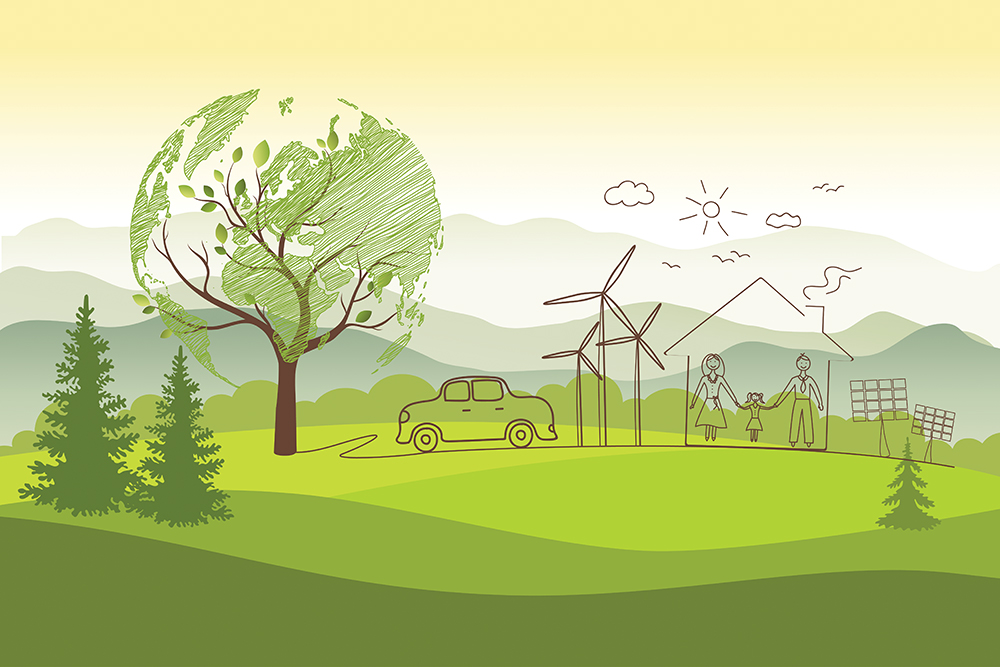10 Cost-Effective Ways to Shift to Clean Power
By Staff | Spring 2020 | Clean Power Guide
As Marbletown, NY finalizes its plan to help the whole community shift to 100-percent renewable energy, we are focused on how to inspire and involve people—realistically and without pressure. We’ve come up with a pledge campaign, combined with customized assistance for participants. Instead of asking people to change (and pay for) everything right away, we’re encouraging folks to plan now how they will choose renewables when they need to replace a boiler, appliance, or vehicle. Some actions save money from day one, and we encourage people to start with those immediately. So we offer the pledge as 10 cost-effective steps:
Choose green electricity.
If your town has joined a Community Choice Aggregation (CCA) program to buy 100 percent green electricity, usually at reduced cost, just participate. If your town is not in a 100 percent renewable CCA, encourage your town board to join.
Opt for solar or community solar power.
By signing up for community solar, you can get up to 10 percent savings on your electricity bill with no upfront cost and no termination fee. Anyone who pays an electric bill who does not have solar on their roof is eligible. If you have a suitable roof and you can benefit from the tax credits, home solar is a great investment.
Take control with energy efficiency. Conduct a DIY home energy audit. Free guidance is available at energy.gov/energysaver/home-energy-audits/do-it-yourself-home-energy-audits.
Choose efficient electrics.
Use only efficient LEDs in high-use lighting areas. When buying appliances, look for Energy Star appliances, and compare annual usage between models.
Improve comfort with insulation and air sealing.
Wherever accessible, insulate and air-seal critical areas like the rim joist around your basement or crawl space and your attic.
When you replace your roof, add insulation and air sealing under the new (preferably nonfossil-based) roofing material if you cannot add insulation to your attic.
When you replace or add siding, install continuous insulation under the siding.
Whenever any work is done on an exterior wall of your building, take the opportunity to reduce air leakage and add insulation if possible.
Choose green transportation.
Be EV ready. The next time you have electrical work done, ask the electrician to also install an electric vehicle (EV) charger or electric vehicle charger-ready circuit (50A 240V) with a NEMA 14-50 outlet near your parking space(s).
Plan that the next vehicle you purchase will be an all-electric or plug-in hybrid electric vehicle (PHEV). If there is not currently a model that meets your needs or budget (i.e., you need a pickup truck), use your old vehicle as long as possible. Or purchase only used vehicles that are as fuel-efficient as possible (e.g. hybrid cars and trucks). If new EVs or PHEVs are too expensive, look into a used one.
Make your next home heating and cooling systems 100 percent renewable.
If you install or replace an air-conditioning unit, do so with a cold climate-rated, air-source heat pump or geothermal heat pump.
If you install or replace a boiler or furnace, choose a cold climate-rated air-source heat pump, geothermal heat pump, or EPA-rated wood or wood pellet furnace or heater.
Replace your water heater with a heat pump, hybrid water heater because wood is renewable, but not so clean unless your stove is quite new.
Even though wood is renewable, all but the newest woodstoves pollute significantly.
If you use a gas fireplace, wood-burning fireplace, or woodstove that’s more than 10 years old, replace it with an EPA 2020-qualified woodstove or wood pellet stove, or another renewable choice.
If you use wood for heat, store your wood with protection from rain and snow, and obtain wood well in advance so that it has time to dry fully.
Cook, wash, and dry renewably.
Use efficient electric appliances, and use the eco settings (and/or hang a clothesline for drying).
Practice green yard care and handywork. Choose electric for small tools and power equipment such as lawn mowers, snow blowers, generators, chainsaws, and more. They come corded or battery powered.
Consider alternative water heaters.
Replace your water heater with a heat pump, hybrid water heater, electric on-demand water heater, solar water heater, electric tank water heater, or auxiliary heater run off a high-efficiency wood or wood pellet furnace.
By shifting to renewable energy as you make replacements, you can reduce costs, frontload savings, plan for financial outlays, and factor in paybacks. Any business selling an EV, solar array, heat pump, or home storage system should offer finance plans. And there are state and utilies incentives and rebates. So get educated about the technologies and economics!
Learn more, and help others learn.
Start learning about these options so that you’re ready when it’s time to make your first purchases or replacements. Share what you’re learning freely with your neighbors and friends.
Clean Power Savings
NO UPFRONT COST INSTANT SAVINGS
Community Solar
COSTS NO MORE THAN FOSSIL OPTION INSTANT SAVINGS
Used EV
Heat Pump Water Heater (some situations)
Air-Source Heat Pump (best case)
Community Choice Aggregation
Electric Lawn mower, snowblower, other yard tools
Many Efficient Appliances
LOW COST QUICK SAVINGS
Building air sealing and insulation (sometimes)
Heat Pump Water Heater (some situations)
LED Light Bulbs
Buy firewood early
Keep firewood covered
Many Efficient Appliances
Smart Thermostat
LARGER INVESTMENT QUICK PAYBACK
Building air sealing and insulation (sometimes)
Air Source Heat Pump (sometimes)
EV, if you drive a lot
Wood Pellet Stove or EPA-certified wood stove (some situations)
LED light bulbs
LARGER INVESTMENT BETTER THAN STOCK MARKET RETURNS
Home solar
Solar Hot Water (high, consistent water use)
Building air sealing and insulation (sometimes)
Air-Source Heat Pump (sometimes)
Geothermal/Ground Source Heat Pump
Wood Pellet Stove or EPA-certified wood stove (some situations)
Wood Pellet Boiler
Some Electric Vehicle
NOT GREAT INVESTMENT BUT OTHER BENEFITS
Building air sealing and insulation (sometimes)
Induction stove or Hot plate
Solar Hot Water
Some Electric Vehicles
Install Electric Vehicle Charging
Home Battery Backup (best with home solar)
